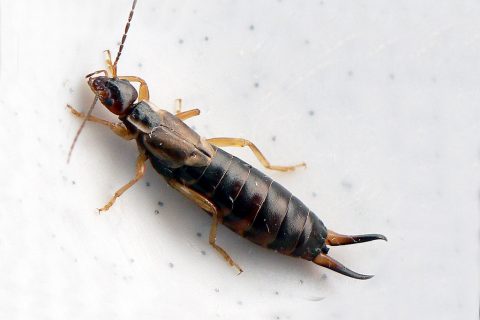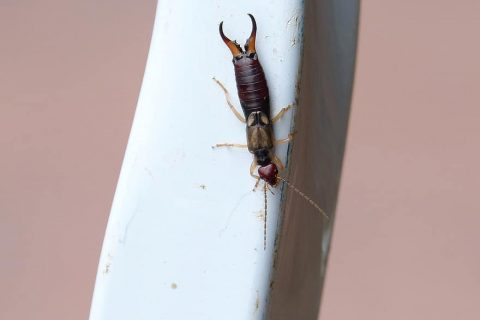Any Questions? Call us today!
All You Need To Know About Earwigs


All You Need To Know About Earwigs
Pincher bugs (more commonly known as earwigs) are small insects that are a part of the Dermaptera order and that have been around for more than 200 million years. There are more than 2,000 species of earwigs today, and they got this name because it was once thought that they like to crawl and live in human ears. French people call them “ear piercers”, while Germans call them “ear worms”.
They live in most parts of the world, but they do prefer warm and humid climates, so you are more likely to spot them during the summer. They are more active at night and tend to hide during the day, and they are also very fast movers. They prefer to stay in dark and damp spaces, so you will most likely find them in your basements or woodpiles. This is also because they feed on decaying wood and plant material. They usually live together in large numbers, and if they lay nests and multiply in your garden or basement, that’s when they can become a problem.
What Do Earwigs Eat?
These insects are omnivores. They feed on decaying plants, wood and animal matter, but also with other insects, spiders, eggs, maggots, grubs or army worms. If their number gets out of hand and they don’t find other sources of food, they will start eating living plants, vegetables, fruit trees and flowers. They sometimes hide underneath pots during the day and then eat the flowers in the pots during the night.
So the question posed by many gardeners is: should you let them in the garden in order to eat other pests, or should they be removed before they start feeding on the vegetables and flowers?
Do Earwigs Pinch? Are They Dangerous?
While their pincers might look scary, the earwigs cannot exert enough pressure to cause any damage to people. They usually use them to ward off enemies, and sometimes to catch prey. Besides this, they also play a role in gender differentiation: males have long and curved pincers, while females have them short and straight.
Earwigs Damage
While their intention is not to harm people or to eat their brain, they can make quite a lot of damage to the garden. They will feed on the plants and they will appear jagged and full of holes. You will also find earwig excrements on the leaves and the plants will eventually die. Most damage occurs after rainy weather, as this forces them to seek dry shelter and climb on the plants.
Besides the damage caused to plants and wood, they can also produce a bad smell when disturbed, especially when they are in large number. And least but not last, they can get on your body, your clothes and even your ears. This is why you need to take action as soon as you notice too many earwigs in your home, basement or garden.
How To Identify Earwigs
They have a size of about ¾ inch long, a brown-reddish colour and appendages on their tail which look like forceps. Not many other insects have similar pincers, so they are easy to recognize. And this is the reason why they are also known as pincher bugs.
While they don’t do this so often, they can also fly if needed, thanks to their two sets of wings. But they usually prefer to make a run for it, as they can move very quickly.
They like to lay their eggs in underground tunnels, and they can lay up to 50 at a time. Being protected from predators, the eggs will hatch in about 1 week. Since they are hidden, they are hard to get rid of before they hatch, and this is why you will mostly see nymphs and adult insects. The nymphs look very similar to adult earwigs (just smaller) and they reach adulthood in ten weeks.
Do Earwigs Get in Your Ears?
These insects have a bad reputation for thousands of years, and they are believed to get into human ears, lay their eggs there and even eat your brain. Yes, there are recorded cases of earwigs getting in people’s ears, but so there are cases of spiders, flies, bugs, crickets and other insects that have crawled into human’s ears or mouth.
Their goal is not to get there and they do not feed on human flesh or brain. In their attempt to run and to hide, they will get into any dark and hidden place they can find, including a human ear. It is very unlikely for this to happen, but it’s not impossible either. And regarding the “brain eating” part, they do not have the ability or the inclination to do this. They simply prefer other sources of food.
Get Rid of Earwigs Now!
If your home or yard are seriously infested by these insects, then it’s time to call a specialist! Safeguard Pest Control is a family owned and operated company that has been operating since 1989. We have extensive knowledge and experience in this field, and can provide you with professional results.
We will begin by inspecting your home and find out where the problem. We will then come up with an action plan and get you informed about the treatment methods and the costs.
Whether you have issues with earwigs, wasps, moths, bees, termites, lawn grubs, mice, rats, geckos, fleas, mosquitoes, flies, bed bugs, Silverfish, pantry pests, beetles or ticks, we are here to help!
Book your Safeguard treatment now by calling 07 5477 6675 or emailing info@safeguardpestcontrol.com.au and allow us to protect your family against these annoying insects.
Use the form below to request a Free Estimate . Requests are answered within 4 hours or less.
